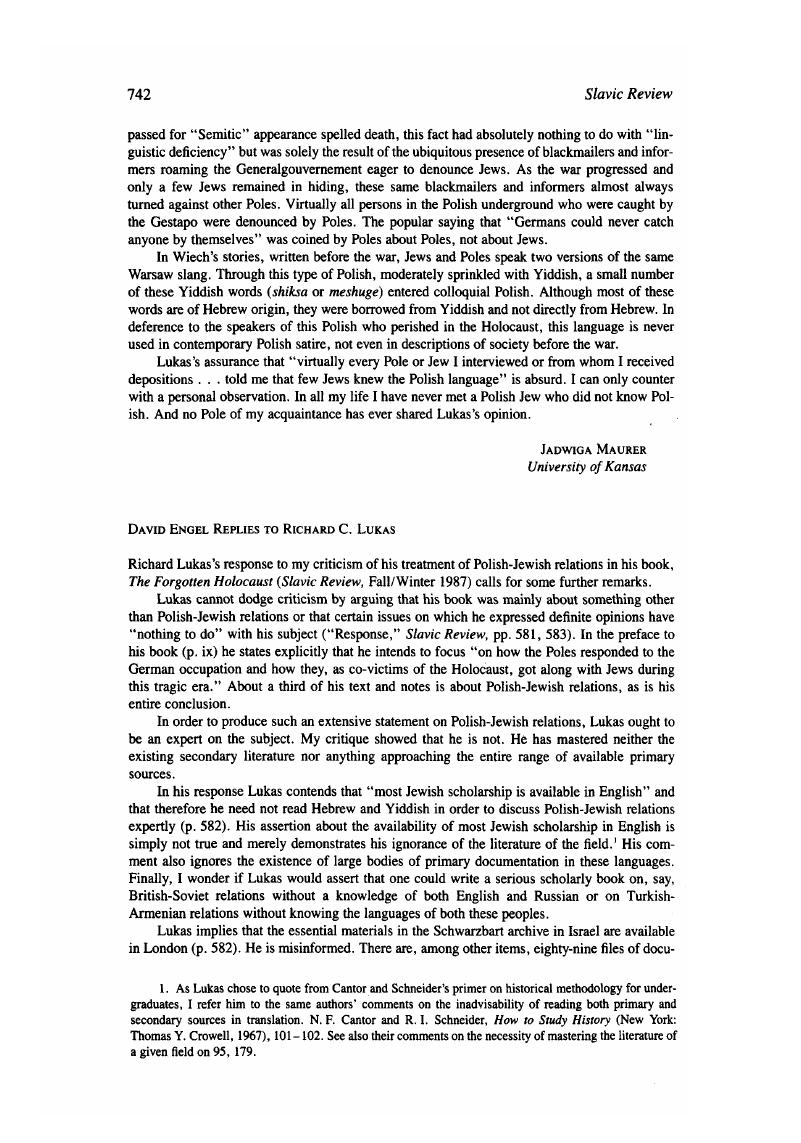No CrossRef data available.
Article contents
David Engel Replies to Richard C. Lukas
Published online by Cambridge University Press: 27 January 2017
Abstract

- Type
- Ongoing Discussion
- Information
- Copyright
- Copyright © Association for Slavic, East European, and Eurasian Studies. 1991
References
1. As Lukas chose to quote from Cantor and Schneider's primer on historical methodology for undergraduates, I refer him to the same authors’ comments on the inadvisability of reading both primary and secondary sources in translation. N. F. Cantor and R. I. Schneider, How to Study History (New York: Thomas Y. Crowell, 1967), 101 -102. See also their comments on the necessity of mastering the literature of a given field on 95, 179.
2. Compare, for example, Lukas, Richard C., The Forgotten Holocaust (Lexington: University Press of Kentucky, 1986), 125Google Scholar, with Davies, Norman, God's Playground: A History of Poland (Oxford: Oxford University Press, 1980), 262–263 Google Scholar; Lukas, Forgotten Holocaust, 124, with Steven, Stewart, The Poles (New York: Macmillan, 1982), 313 Google Scholar; Lukas, “Response,” Slavic Review, 583n5 (portions not included in quotation marks), with Norman Davies, “Great Britain and the Polish Jews, 1918-20,” Journal of Contemporary History 8, no. 2 (1973): 130. Incidentally, this last article, contrary to Lukas's assertion, contains no justification for the statements made in Forgotten Holocaust (statements actually taken from Davies's God's Playground) concerning the events in Lvov in 1918 and Pinsk in 1919. Nowhere in this article does Davies analyze in detail what happened in Pinsk and Lvov; in fact, he mentions Lvov only in passing and Pirtsk not at all. Moreover, the article does not provide the name of the American investigator whom Lukas, borrowing from Davies, says “considered [what happened in Pifisk] justified under the circumstances. “
3. Golczewski, Frank, Polnisch-judische Beziehungen 1881-1922 (Wiesbaden: Steiner, 1981), 185-205, 219-229, 240–245 Google Scholar; Reiss, Anshel, BeSa'arot haTekufah (Tel Aviv: Am Oved, 1982), 52–68 Google Scholar; Marcus, Joseph, Social and Political History of the Jews in Poland, 1919-1939 (Berlin: Mouton, 1983), 148–162 CrossRefGoogle Scholar; Melzer, Emanuel, Ma'avak Medini beMalkodet (Tel Aviv: Diaspora Research Institute, 1982 Google Scholar, especially 192-195 but also passim. None of the aforementioned works presents the last word on any of the treated subjects; my only point is that Lukas has nothing to add to any of their discussions and thus has no sound justification for ignoring their findings and evidence.
4. Gutman, Yisrael, “Jews in General Anders’ Army in the Soviet Union,” Yad Vashem Studies 12 (1977): 243–245 Google Scholar; K Nussbaum, alman, VeHafach lahem leRo'ets (Tel Aviv: Diaspora Research Institute, 1984), 54–55 Google Scholar. Gutman cites the eyewitness testimony of Anders's adjutant, General Jerzy Klimkowski, to the effect that on 11 November 1941 Anders requested senior Soviet military officials to ban enlistment of Jews, Ukrainians, and White Russians into the Polish army. Nussbaum has located the minutes of this conversation in the archives of the Polish Institute in London and they bear out Klimkowski's statement. He has also located a 1941 order by Anders stating, inter alia, “the number of national minorities may not exceed 5 percent of noncommissioned officers and 10 percent of privates in all units. “
5. The archives of Zegota are divided between Centralne Archiwum Komitetu Centralnego Polskiej Zjednoczonej Partii Robotniczej and Archiwum Zydowskiego Instytutu Historycznego, both in Warsaw. Copies of the documents from both institutions are located at Yad Vashem (record group 06.48). Prekerowa, Teresa, Konspiracyjna Rada Pomocy Zydom w Warszawie 1942-1945 (Warsaw: Paristwowy Instytut Wydawniczy, 1982 Google Scholar.
6. See especially the messages from Zegota to the government delegate sent during 1943, Yad Vashem Archives, 06.48/10a; Jan to RPZ, 4 March 1943, ibid.; Prekerowa, Konspiracyjna Rada, 262-295. Lukas also overlooked the document from the Zegota archive published in a gloss to Ringelblaum, Emmanuel, Polish Jewish Relations during the Second World War (New York: Howard Fertig, 1976), 123.Google Scholar
7. Some of these documents are cited and analyzed in Engel, David, In the Shadow of Auschwitz (Chapel Hill: University of North Carolina Press, 1987), 161-169, 238-239, 297.Google Scholar
8. Engel, David, “An Early Account of Polish Jewry under Nazi and Soviet Occupation Presented to the Polish Government in Exile, February 1940,” Jewish Social Studies 45, no. 1 (1983): 1–16.Google Scholar
9. “Poles and Jews: An Exchange,” New York Review of Books, 9 April 1987, 43. I have several objections to Davies's translation. My own translation was checked by Karski for accuracy.
10. I used Jan Tomasz Gross's translation from Polish Society under German Occupation (Princeton, N.J.: Princeton University Press, 1979), 184-185, because I had no way of knowing whether Lukas had actually seen the document and wished to prove that even though he knew of its existence from Gross's book he declined to inform his readers about it.
11. A more extensive excerpt has been published in Polish by Jan Gross, Tomasz, “Ten jest z ojczyzny mojej, ale go nie lubie,” Aneks, 41-42 (1986): 28–29.Google Scholar
12. David Engel, “Semantikah uFolitikah beTe'ur haYehasim bein Polanim veYehudim,” Spiegel Lectures in Modern Jewish History, Tel Aviv, forthcoming.


